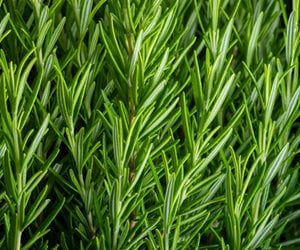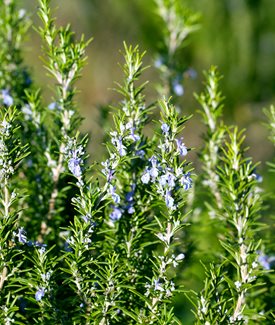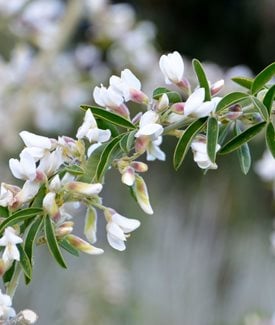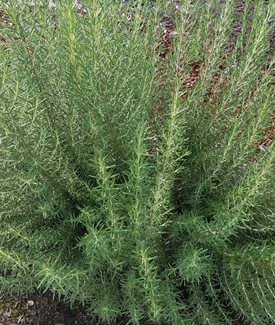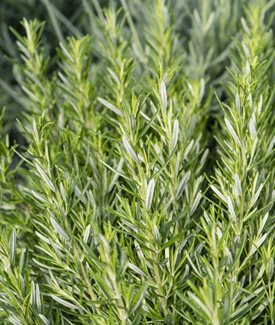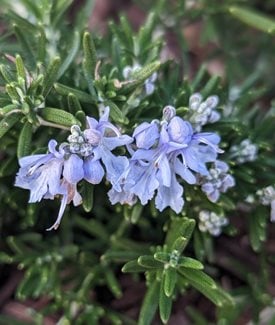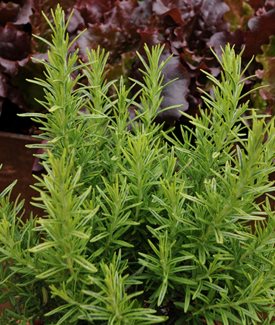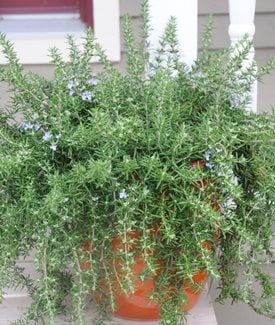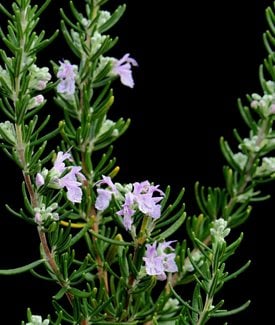A GUIDE TO GROWING ROSEMARY
Grow this versatile aromatic herb for ornamental and culinary useRosemary is a perennial evergreen shrub grown for its aromatic leaves that are used for culinary, medicinal, and other purposes. Not only is rosemary highly useful, it also makes an attractive landscape plant.
Native to the Mediterranean region, rosemary has been grown and used for thousands of years. This tough plant is tolerant of heat and drought, needing minimal care once established. There are different types of rosemary that can be grown in beds, borders, and containers. Here’s how to grow and use this versatile herb.
On this page: Basics | Planting | Care | Varieties | Landscaping Ideas | Frequently Asked Questions | Harvest & Use Rosemary
On this page:
- ROSEMARY BASICS
- PLANTING ROSEMARY
- ROSEMARY CARE
- BASIL VARIETIES
- LANDSCAPING IDEAS
- FREQUENTLY ASKED QUESTIONS
- HOW TO HARVEST & USE ROSEMARY
BASICS
Botanical name:
Salvia rosmarinus, formerly known as Rosmarinus officinalis
Plant type:
Woody perennial, evergreen
Zones:
8-11, some may be hardy to Zones 6-7 with winter protection
Exposure:
Full sun
Growth habit:
Upright, bushy, mounding or spreading ground cover habit
Height/Spread:
2 to 6 feet tall and wide, depending on the variety
Bloom time:
Late winter to fall, depending on the variety
Foliage:
Slender needle-like leaves grow along erect woody stems in shades of green or variegated green and gold.
Flowers:
Tiny tubular flowers occur in clusters along the branches. Flower color is most often pastel blue, but can also be pale pink or white.
Benefits and other attributes:
The flowers are attractive to bees and other insect pollinators. Rosemary adds texture, color, structure, and fragrance to beds, borders, and containers.
Toxicity:
Rosemary is safe for humans. Dogs and cats can safely ingest rosemary in small amounts. Larger amounts may cause stomach distress. Essential oils made from rosemary are not safe due to their concentration.
Is rosemary deer resistant?
Deer find the aromatic foliage of rosemary to be distasteful, though damage can occur on almost any plant if other food sources are scarce.
PLANTING ROSEMARY
When to plant:
Plant outdoors in spring when all danger of frost is past.
Where to plant:
When planting rosemary, choose a site that gets at least 6 to 8 hours of direct sun per day. Make sure there is adequate drainage.
How to plant:
Loosen soil in the planting area and amend as needed to improve drainage. Dig a hole twice as wide and slightly shallower than the root ball. Remove plant from the nursery container and loosen roots if potbound. Place in the hole so the top of the root ball is slightly higher than the surrounding soil. Fill in the hole with soil, tamp down gently to remove air pockets, and water thoroughly. Water regularly until established. Space plants 2 to 4 feet apart to allow for good air circulation.
Growing rosemary from seed:
Rosemary can be grown from seed, but germination rates can be low and seedlings are slow-growing. Start seeds indoors 2 to 3 months before your last average frost-free date. Scatter seeds in pots or trays filled with seed starting mix and lightly cover with mix. Cover with plastic wrap and place in a warm room or on a heat mat. Seeds need temperatures of 65-80 degrees F to germinate. Don’t allow soil to dry out. When seeds germinate in 2 to 4 weeks, remove plastic and move trays into bright light. When plants are several inches tall, transplant outdoors into beds or pots.
Planting rosemary in pots:
Use a container that is slightly larger than the root ball. Make sure pots have adequate drainage holes. Plant in a high quality all-purpose potting mix, adding perlite or pumice for extra drainage if needed. Bring pots inside before the first hard freeze and set plants back out in spring when all danger of frost is past.
Propagation:
Rosemary plants can be propagated from cuttings. In spring or summer, cut off a branch tip with new softwood growth to a length of 4 to 6 inches. Remove lower leaves and dip the bottom of the stem in rooting hormone. Plant in soilless potting mix or seed starting mix and place in a warm spot with bright indirect light. Cuttings will root in 1 to 3 months. Transplant rooted cuttings into garden beds or containers.
Learn more about planting & growing herb gardens.
ROSEMARY PLANT CARE
Temperature and humidity:
Rosemary performs best with warmer weather and moderate air humidity, with ideal temperatures between 55 to 80 degrees F. In areas with high humidity, plants are more susceptible to fungal diseases. In regions below Zone 8, plants can be grown in containers and overwintered indoors.
Soil:
Rosemary can grow in poor soil as long as there is good drainage. Provide lean, sandy or loamy soil that drains well with a slightly acidic to neutral pH of 6.0 to 7.0. Poorly draining or clay soil may cause root rot.
Amendments & fertilizer:
Rosemary plants need little or no supplemental fertilizer. Amend soil with compost at the time of planting. If desired, apply a layer of compost around the base of plants or use an all-purpose balanced fertilizer in early spring before new growth appears.
Watering:
Rosemary is drought tolerant once established. It’s better to underwater than to overwater plants. Allow the top several inches of soil to dry out between waterings. Water rosemary plants until the soil is evenly moist but not soggy.
Pruning and deadheading:
Prune rosemary in early spring. Cut out any dead, diseased or misshapen branches. When plants are finished flowering, lightly shape as needed. Plants can be cut back by up to a third of their size. Avoid cutting into older woody growth; plants may not regenerate from old wood. Young plants can be trained into a tree form or topiaries.
Indoor care for rosemary plants:
Rosemary can be grown as an indoor houseplant. Place in a south-facing window that gets the most light, or use grow lights. Keep plants evenly moist but don’t overwater. Plants will benefit from being placed outdoors during warmer months.
Pests and diseases:
When given optimal growing conditions, rosemary is resistant to pests and diseases. Pests can include thrips, aphids, mealybugs, spider mites, and whitefly. Diseases, which are primarily caused by overwatering or humid conditions, include botrytis, powdery mildew, and root rot.
ROSEMARY VARIETIES
FREQUENTLY ASKED QUESTIONS
How long does a rosemary plant live?
The average lifespan for rosemary plants is 10 years, though some may survive 15 to 20 years.
Is rosemary safe for dogs?
Rosemary is generally safe for dogs in small amounts. Consult your veterinarian for the best advice for your pet.
Does rosemary plant come back every year?
Rosemary is perennial in USDA zones 8-11 and grown as an annual in colder zones.
LANDSCAPING IDEAS FOR ROSEMARY PLANTS
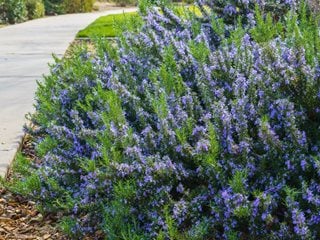
Photo by: Hanna Tor / Shutterstock
For borders and landscapes: Larger upright types can be used in beds and borders, as hedging, screening, or a background plant.
For slopes and hillsides: Mass an upright or groundcover type on a slope or hillside to help stem erosion.
For containers: Small to medium-sized specimens can be planted in containers and placed on a patio or deck, or used as a focal point in the landscape.
There are many ways to use rosemary in your garden. Here’s how:
- Plant rosemary in a container and place near your kitchen or outdoor eating area where you can easily snip off a few sprigs for cooking.
- Combine rosemary bushes in a waterwise border with other drought-tolerant plants.
- Mass a low-growing, spreading rosemary variety along a slope, berm, or rock wall as a decorative ground cover that will help stabilize the soil.
- Plant rosemary topiaries in classic stone urns and place on either side of a pathway for classic formal elegance.
- Create a kitchen garden using herbs such as rosemary, mint, lavender, thyme, oregano, and chives, adding vegetables and flowers such as calendula, marigold, and nasturtium for a colorful edible display all summer long.
- Rosemary can be planted in a rock garden.
- Plant a curbside strip with rosemary and other tough low-maintenance plants.
- Create a Mediterranean-style garden and plant rosemary alongside other popular Mediterranean plants such as artemisia, Jerusalem sage, lavender, cistus, sage, succulents, and spurge.
- Use a medium-sized variety of rosemary as hedging between garden rooms.
- Plant a larger variety in a row to soften a fence or wall.
Rosemary companion plants: Good companion plants for rosemary include alyssum, beans, broccoli, cabbage, carrots, chives, lavender, marigold, onion, sage, strawberries, and thyme.
HOW TO HARVEST AND USE ROSEMARY
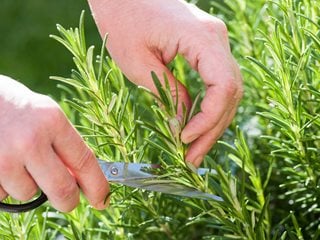
Photo by: Alexander Raths / Shutterstock
Harvesting: Rosemary can be used fresh or dried and harvested at any time of year. It is most flavorful during spring and summer when the aromatic oils are at their peak. Harvest fresh rosemary sprigs during cooler hours of the morning, cutting off stem tips in 4- to 6-inch lengths. Use sprigs fresh or hang in a cool dry place for 2 weeks. Strip dried leaves off the stems and store in an airtight container.
For cooking: Rosemary has a pungent, savory taste that pairs well with many foods. The complex flavor is described as being woodsy and peppery, with hints of citrus, mint, and pine. Use fresh or dried leaves as a meat rub, in marinades, to season vegetable dishes, salad dressing, soup, stew, pasta, sauces, bread and other baked goods, cocktails, olive oil, and desserts. Mix with butter or soft cheese to use as a flavored spread. Rosemary can be brewed into tea.
Medicinal use: Rosemary has many health benefits, as an astringent, to ease joint and muscle pain, improve digestion and circulation. This herbal remedy is thought to have anti-cancer, anti-inflammatory, and immune-boosting properties. It may also improve memory, reduce anxiety and stress, and improve sleep. The leaves of rosemary contain carnosic acid, also known as “extracts of rosemary,” which are used as antioxidant preservatives in food products.
Other use: Rosemary is used as an ingredient in hair and skin products, toiletries, essential oils, lotions, and soaps. The pungent leaves repel insect pests. Leaves and branches can be used for crafts such as wreaths, sachets, and dried arrangements.
RELATED:
20 Mediterranean Plants for Your Garden
15 Best Herbs to Grow
